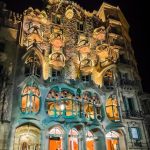Lluís Domènech i Montaner, a pioneering architect and key figure in the Catalan Modernisme movement, left an indelible mark on the architectural landscape of Catalonia during the late 19th and early 20th centuries. Born on December 21, 1850, in Barcelona, Spain, Domènech i Montaner’s early exposure to art and culture, combined with a strong familial connection to architecture, set the stage for a career marked by innovation, cultural revival, and a deep commitment to the Catalan identity.
Coming from a family of architects, Domènech i Montaner’s destiny seemed intertwined with the built environment. His father, Pere Domènech i Roura, was a noted architect, and Lluís inherited a passion for the profession. At the age of 17, he began his formal education at the Barcelona School of Architecture (Escola Tècnica Superior d’Arquitectura de Barcelona), where he was exposed to the eclectic architectural styles of the time.
During his formative years, Domènech i Montaner’s intellectual curiosity extended beyond architecture. He engaged with the burgeoning cultural and political movements in Catalonia, fostering a deep appreciation for the region’s distinct identity. This multifaceted approach would later manifest in his architectural designs, reflecting a synthesis of cultural, artistic, and social influences.
Catalan Modernisme
The late 19th century witnessed the emergence of Catalan Modernisme, a cultural and artistic movement that sought to redefine Catalonia’s identity while embracing modernity. Lluís Domènech i Montaner became a leading exponent of this movement, contributing significantly to its architectural expression. His designs embodied the spirit of Modernisme, characterized by a departure from historical revivalism and an embrace of innovative forms, materials, and ornamentation.
One of Domènech i Montaner’s early works that encapsulated the principles of Modernisme was the Café-Restaurant of the Casino of Manresa (1888). The design showcased his exploration of new structural techniques, incorporation of decorative elements inspired by nature, and a commitment to creating immersive spaces that transcended mere functionality. The project marked the beginning of Domènech i Montaner’s architectural journey towards a more modern and distinctive aesthetic.
The pinnacle of his Modernisme expression came with the design of the Sant Pau Art Nouveau Site (Recinte Modernista de Sant Pau) in Barcelona. Conceived as a hospital complex, the site became a testament to Domènech i Montaner’s vision for an integrated, aesthetically pleasing environment that prioritized both functionality and artistic expression. The use of vibrant colors, intricate mosaics, and innovative structural solutions demonstrated his mastery of the architectural language of Modernisme.
Cultural and Civic Contributions
Beyond his architectural achievements, Lluís Domènech i Montaner made significant contributions to cultural and civic life in Catalonia. He was a prominent intellectual figure, engaging in public discourse through his writings and participation in cultural societies. Domènech i Montaner’s commitment to the Catalan Renaixença, a cultural revival movement, manifested in his efforts to revive traditional crafts and celebrate the region’s artistic heritage.
His involvement in education and academia further solidified his influence. Domènech i Montaner served as the director of the Barcelona School of Architecture and played a crucial role in shaping the curriculum to reflect modern architectural trends. His advocacy for a holistic approach to architectural education, incorporating artistic and cultural elements, laid the foundation for future generations of architects in Catalonia.
In addition to his educational endeavors, Domènech i Montaner engaged in civic projects that aimed to enhance public spaces. His design of the Palau de la Música Catalana, a concert hall in Barcelona, stands as a testament to his belief in the transformative power of architecture on society. Completed in 1908, the Palau de la Música Catalana became an architectural jewel, celebrated for its innovative use of natural light, ornamental richness, and dedication to the communal experience of music.
Legacy and Recognition
Lluís Domènech i Montaner’s legacy is deeply interwoven with the architectural and cultural history of Catalonia. His pioneering approach to Modernisme, characterized by a harmonious blend of innovation, tradition, and cultural identity, left an enduring impact on the architectural landscape. The Sant Pau Art Nouveau Site and the Palau de la Música Catalana stand as iconic symbols of his creative genius and commitment to elevating the human experience through architecture.
In 2010, the Sant Pau Art Nouveau Site was designated a UNESCO World Heritage Site, recognizing its cultural and architectural significance. The accolade not only celebrated Domènech i Montaner’s individual achievements but also underscored the broader recognition of Catalan Modernisme as a pivotal movement in the history of architecture.
Lluís Domènech i Montaner’s multifaceted legacy extends beyond physical structures. His role as a cultural advocate, educator, and intellectual contributed to the shaping of Catalonia’s cultural identity during a crucial period of transformation. His commitment to fostering a sense of place, rooted in the region’s artistic and historical heritage, continues to inspire architects and cultural enthusiasts alike.
As Catalonia navigated its complex sociopolitical landscape, Domènech i Montaner’s legacy served as a touchstone for those seeking to embrace modernity while preserving and celebrating the richness of cultural identity. The enduring relevance of his architectural and cultural contributions reaffirms Lluís Domènech i Montaner as a visionary whose impact transcends the boundaries of time, leaving an indelible imprint on the architectural narrative of Catalonia and beyond.




